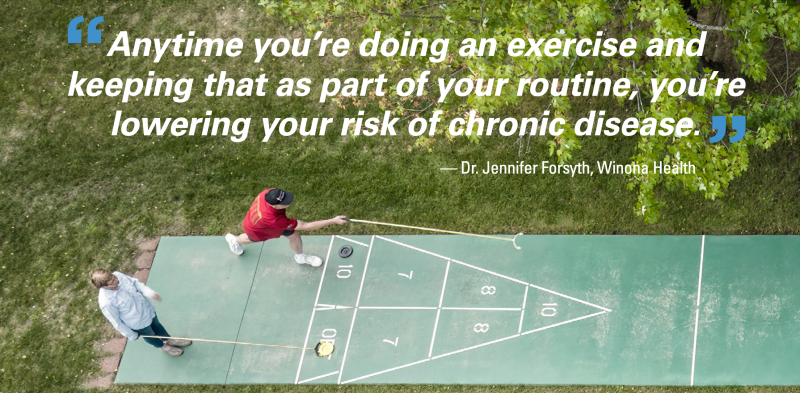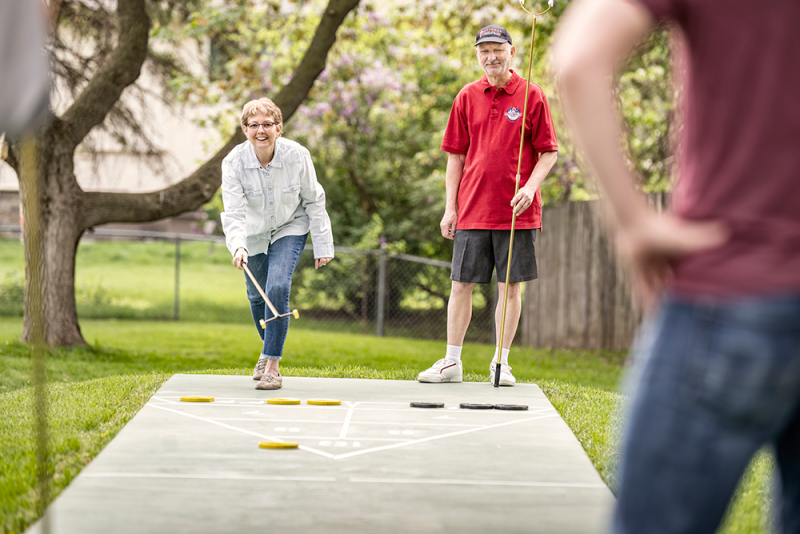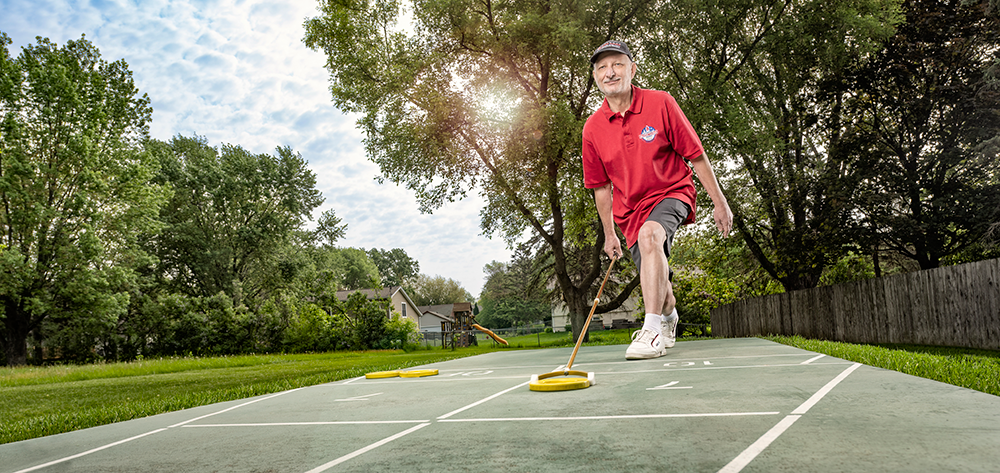For Blue Cross member Bill Salo, shuffleboard began as a family affair later in life. He picked up the sport — which involves using a cue to push weighted discs down a narrow court — at a Senior Games event in his 50s, after an invite from his parents. During the last two decades, he’s played in doubles with his father, cousins, his former wife, and friends, earning medals at events throughout the Midwest and nationally. He’s also found success in individual competition, winning five gold medals, a bronze and a silver at the national Senior Games since 2003.
“Shuffleboard is a pretty easy sport to get into and I love the competition, the challenge of it,” says Salo, now 71. “I also enjoy the camaraderie. I’ve made a lot of friends and we all want each other to do well.”

Salo, also a competitive bowler, regular walker, and gym user through SilverSneakers® credits active living for helping him stay healthy and happy into his 70s. Research backs up the benefits of regular physical activity. It can help manage weight, reduce the risk of disease, strengthen bones and muscles and even improve brain health, according to the Centers for Disease Control and Prevention (CDC).
Dr. Jennifer Forsyth, a board- certified geriatrician at Winona Health, says regular physical activity can take many forms.
“It could be intentional exercise, or it could be gardening, walking, going to get groceries — any of those things are healthy activities”, Dr. Forsyth says. “Try to make a habit of those things that make you move. The more you move, the better your body works and the healthier you’ll be.”
Well-rounded workouts
Though all movement is beneficial, Dr. Forsyth says there are three categories of physical activity that everyone should try to cover regularly: aerobic, strength and balance.
To get in your aerobic activity, you might try walking, swimming, cycling or playing pickleball. You should aim for 30 minutes of sustained aerobic activity a day, five days a week. Aerobic activities can be moderate and should increase your breathing and heart rate, but they do not have to be intense. It’s important to do what you feel is comfortable.
Strength training is especially important for maintaining muscle mass and strong bones, which can help us get around safely and perform daily activities. Exercises might involve lifting weights, using resistance bands, or even doing vigorous yard work. Try to work different parts of your body — doing squats as one exercise and arm extensions for another, for example. If you don’t have weights or bands, cans of vegetables or similar household items can work. Strength exercise should be done twice a week, for 20 to 30 minutes. The CDC suggests one-to-three sets of eight to 10 repetitions each for each exercise you do.
Dr. Forsyth says balance exercises should be done three times a week, for 30 minutes at a time. Examples include yoga, tai chi, or even walking sideways or repeatedly standing up from a seated position. Balance activities can help improve coordination and prevent falls.
Stay Sharp
![]()
The strategy and score keeping involved in shuffleboard and other games are a good way to exercise your mind as well as your body.
Before starting any new exercises or activities, be sure to talk to your doctor about a routine that might be best for you. It is important to consider your health history, including injuries or chronic conditions, and what activities will provide improvement without causing or worsening symptoms. For the most part, however, physical activity has been shown to alleviate symptoms associated with many chronic conditions, such as joint pain from arthritis. Exercise can also help to prevent conditions from surfacing in the first place.
“Anytime you’re doing an exercise and keeping that as part of your routine,
you’re lowering your risk of chronic disease,” Dr. Forsyth says. “Especially as people get older, more activity means lower risk. People who are active are also stronger, can do more for themselves and be more independent.”
Brain benefits
Exercise has been shown to improve oxygen to the brain, lessening risk of cognitive problems, such as memory loss. The CDC says it can help you think, learn, problem solve and balance emotions.
“You will also get those endorphins going, those positive hormones flowing in your body, which can help to avoid depression,” Dr. Forsyth says.
People who are sedentary are also at higher risk of sudden confusion or a lack of awareness of their surroundings, known as delirium.
“Delirium is one of those things that we really don’t want to see if we can avoid it and exercise helps mitigate that,” Dr. Forsyth says.
She also suggests getting friends or family involved in your exercise routine. Making exercise a social habit can help keep you on track and make it something to look forward to.
Anytime you’re doing an exercise and keeping that as part of your routine, you’re lowering your risk of chronic disease.
— Dr. Jennifer Forsyth, Winona Health

Did you know?

Shuffleboard was introduced in the U.S. around 1913. The National Shuffleboard Association, founded in the 1930s, standardized the rules and court sizes. SOURCE: BRITANNICA.COM
Getting started
Beginning a physical activity routine might seem daunting for some, but you don’t have to go all-in overnight. Start small, with light activity at shorter intervals, and build gradually. Pain is a common reason for putting off exercise, but done properly, it should actually help to lessen many symptoms. She emphasizes that it’s never too late to start.
“You might even just start with one or two days a week, 10 minutes at a time,” Dr. Forsyth says. “And just increase it very slowly so that you can handle it. Then incorporate different activities that are more fun. Finding something you love doing will help you make it sustainable.”
A passion for shuffleboard and STAY bowling competition keeps Salo looking forward to regional and national Senior Games each year, along with the fellowship he’s developed with other athletes. When he’s not competing, he spends time walking in his neighborhood, using his local gym membership, bowling and keeping up with family and friends. He lost his mother about a decade ago and his father earlier this year, but he’s grateful for the healthy example they set for him. He aims to do the same for his daughter.
“Hopefully she’ll be competing as my doubles partner,” Salo says. “We’re going to keep the family thing going.”
GET MOVING
Getting active shouldn’t have to be a chore. The Centers for Disease Control and Prevention (CDC) suggest a couple of ideas to get started:
Break up sedentary activities
Lift weights or walk in place while watching TV, for example.
Add more activity to your routine
You might use the stairs instead of the elevator, or park farther way from the grocery store door to help get more steps in.
Walk the dog
Research has shown that dog owners get in more steps.In one study, dog owners on average walked 22 minutes more each day than those who didn’t own a dog.


